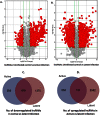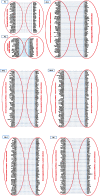Gene-expression reversal of lncRNAs and associated mRNAs expression in active vs latent HIV infection
- PMID: 27756902
- PMCID: PMC5069461
- DOI: 10.1038/srep34862
Gene-expression reversal of lncRNAs and associated mRNAs expression in active vs latent HIV infection
Abstract
Interplay between lncRNAs and mRNAs is rapidly emerging as a key epigenetic mechanism in controlling various cell functions. HIV can actively infect and/or can persist latently for years by manipulating host epigenetics; however, its molecular essence remains undiscovered in entirety. Here for the first time, we delineate the influence of HIV on global lncRNAs expression in monocytic cells lines. Our analysis revealed the expression modulation of nearly 1060 such lncRNAs which are associated with differentially expressed mRNAs in active and latent infection. This suggests a greater role of lncRNAs in regulating transcriptional and post-transcriptional gene expression during HIV infection. The differentially expressed mRNAs were involved in several different biological pathways where immunological networks were most enriched. Importantly, we discovered that HIV induces expression reversal of more than 150 lncRNAs between its active and latent infection. Also, hundreds of unique lncRNAs were identified in both infection conditions. The pathology specific "gene-expression reversal" and "on-and-off" switching of lncRNAs and associated mRNAs may lead to establish the relationship between active and HIV infection.
Conflict of interest statement
The authors declare no competing financial interests.
Figures








Similar articles
-
Transcriptomic study reveals alteration in the expression of long non-coding RNAs (lncRNAs) during reversal of HIV-1 latency in monocytic cell line.Mol Biol Rep. 2024 Oct 30;51(1):1102. doi: 10.1007/s11033-024-10037-2. Mol Biol Rep. 2024. PMID: 39476220
-
HIV-1 active and latent infections induce disparate chromatin reorganization and transcriptional regulation of mRNAs and lncRNAs in SupT1 cells.mBio. 2023 Dec 19;14(6):e0261923. doi: 10.1128/mbio.02619-23. Epub 2023 Dec 1. mBio. 2023. PMID: 38038477 Free PMC article.
-
MALAT1 is important for facilitating HIV-1 latency reversal in latently infected monocytes.Gene. 2025 Feb 5;936:149095. doi: 10.1016/j.gene.2024.149095. Epub 2024 Nov 15. Gene. 2025. PMID: 39549778
-
Long Noncoding RNA uc002yug.2 Activates HIV-1 Latency through Regulation of mRNA Levels of Various RUNX1 Isoforms and Increased Tat Expression.J Virol. 2018 Apr 13;92(9):e01844-17. doi: 10.1128/JVI.01844-17. Print 2018 May 1. J Virol. 2018. PMID: 29491162 Free PMC article.
-
Role of long noncoding RNA in regulating HIV infection-a comprehensive review.mBio. 2024 Feb 14;15(2):e0192523. doi: 10.1128/mbio.01925-23. Epub 2024 Jan 5. mBio. 2024. PMID: 38179937 Free PMC article. Review.
Cited by
-
RNA sequencing of CD4 T-cells reveals the relationships between lncRNA-mRNA co-expression in elite controller vs. HIV-positive infected patients.PeerJ. 2020 Apr 21;8:e8911. doi: 10.7717/peerj.8911. eCollection 2020. PeerJ. 2020. PMID: 32341894 Free PMC article.
-
A Genome-Wide Analysis of Long Noncoding RNAs in Circulating Leukocytes and Their Differential Expression in Type 1 Diabetes Patients.J Diabetes Res. 2020 Nov 25;2020:9010314. doi: 10.1155/2020/9010314. eCollection 2020. J Diabetes Res. 2020. PMID: 33299893 Free PMC article.
-
Inhibition of the lncRNA SAF drives activation of apoptotic effector caspases in HIV-1-infected human macrophages.Proc Natl Acad Sci U S A. 2019 Apr 9;116(15):7431-7438. doi: 10.1073/pnas.1818662116. Epub 2019 Mar 27. Proc Natl Acad Sci U S A. 2019. PMID: 30918127 Free PMC article.
-
Differentially expressed host long intergenic noncoding RNA and mRNA in HIV-1 and HIV-2 infection.Sci Rep. 2018 Feb 7;8(1):2546. doi: 10.1038/s41598-018-20791-6. Sci Rep. 2018. PMID: 29416066 Free PMC article.
-
Long Noncoding RNAs as Diagnostic and Therapeutic Targets in Type 2 Diabetes and Related Complications.Genes (Basel). 2017 Aug 22;8(8):207. doi: 10.3390/genes8080207. Genes (Basel). 2017. PMID: 28829354 Free PMC article. Review.
References
-
- Chun T. W. & Fauci A. S. HIV reservoirs: pathogenesis and obstacles to viral eradication and cure. AIDS 26, 1261–1268 (2012). - PubMed
Publication types
MeSH terms
Substances
Grants and funding
LinkOut - more resources
Full Text Sources
Other Literature Sources
Medical

